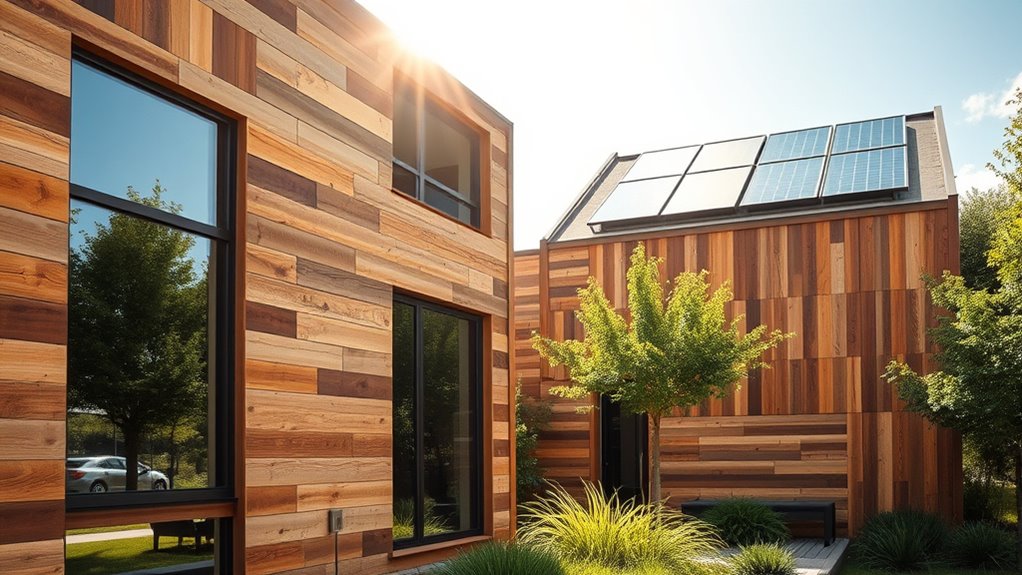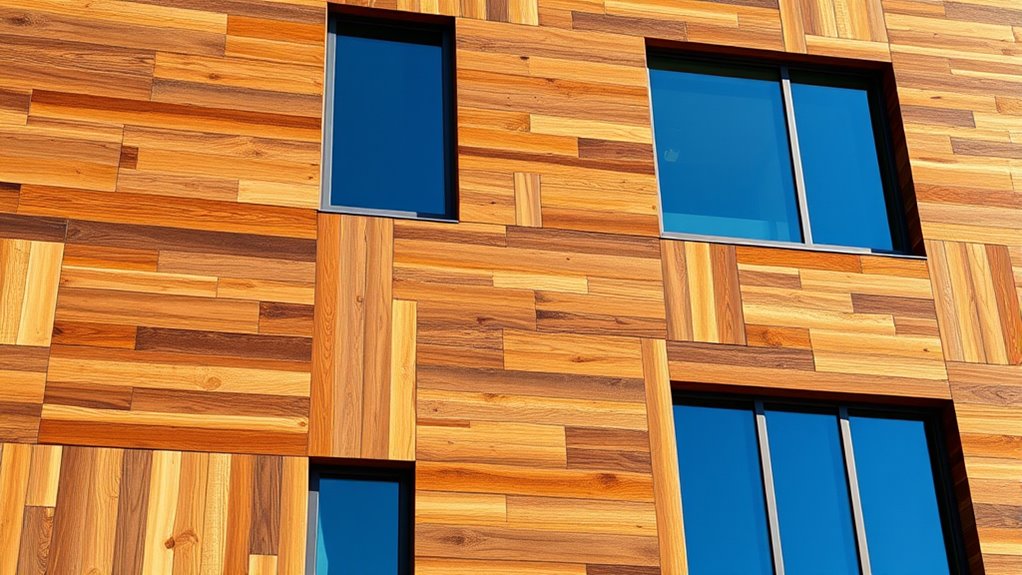Building sustainably with reclaimed wood helps you reduce demand for new timber, conserving natural resources and minimizing environmental waste. When properly cleaned and treated, reclaimed wood is durable, safe, and adds character to your projects. Its versatility allows for unique design options in flooring, walls, and furniture. By choosing reclaimed wood, you support eco-friendly practices while creating beautiful, one-of-a-kind spaces. Keep exploring to discover how to maximize its benefits in your construction or renovation.
Key Takeaways
- Reclaimed wood reduces the need for new timber, conserving natural resources and supporting eco-friendly building practices.
- Proper treatment ensures reclaimed wood is safe, durable, and resistant to pests, mold, and decay.
- Using reclaimed wood adds aesthetic charm and character, enhancing sustainability through design flexibility.
- Integrating reclaimed wood in various applications promotes environmentally responsible construction and reduces waste.
- Collaborating with experienced professionals ensures safe, long-lasting, and environmentally sustainable building outcomes.

Building sustainably with reclaimed wood offers an eco-friendly alternative to traditional construction materials. By choosing reclaimed wood, you reduce the demand for new timber, help divert usable wood from landfills, and lower the environmental impact of your project. This approach not only benefits the planet but also adds a unique aesthetic to your space, showcasing history and character in every piece. When working with reclaimed wood, it’s essential to contemplate proper wood treatment to ensure safety, durability, and stability. You’ll want to thoroughly clean, dry, and treat the wood to eliminate pests, mold, or any contaminants. Proper wood treatment also involves applying finishes that protect against moisture, decay, and insects, extending the lifespan of your reclaimed lumber and maintaining its beauty over time.
Choosing reclaimed wood enhances sustainability and adds unique character while requiring proper treatment for safety and durability.
One of the standout advantages of using reclaimed wood is its impressive design flexibility. Unlike conventional materials, reclaimed wood comes in a variety of sizes, textures, and colors, giving you creative freedom to craft a truly customized look. Whether you’re designing a rustic cabin, a modern loft, or an eclectic commercial space, reclaimed wood can be adapted to fit your vision seamlessly. You can opt for wide planks for a bold statement or smaller pieces for intricate detailing. Its natural imperfections, such as knots, nail holes, and weathered surfaces, add charm and authenticity, elevating your design. Plus, since reclaimed wood often has a storied history, it can serve as a conversation piece, adding depth and interest to your project. Additionally, understanding the properties of reclaimed wood helps in selecting the right pieces for durability and safety.
The versatility of reclaimed wood also extends to its application. You might use it for flooring, wall paneling, furniture, or even structural components, all while maintaining the integrity and character of the material. Its inherent variability means you can mix and match different types of wood, creating a layered, textured effect that’s difficult to replicate with new materials. To maximize your design flexibility, it’s wise to collaborate with professionals experienced in reclaimed wood projects, as they can advise on appropriate treatments and installation techniques. Confirming the wood is properly treated before installation guarantees safety and longevity while allowing you to explore diverse design options confidently.
Incorporating reclaimed wood into your building project not only supports sustainability but also offers a level of customization and aesthetic appeal that standard materials can’t match. With careful attention to wood treatment and an open mind towards design possibilities, you can create a space that’s beautiful, durable, and environmentally responsible.
Frequently Asked Questions
How Does Reclaimed Wood Compare to New Wood in Terms Durability?
Reclaimed wood often matches or exceeds new wood in durability because of its aging effects, which can strengthen the fibers over time. Proper wood treatment guarantees it resists pests and moisture, enhancing longevity. While new wood is uniform, reclaimed wood‘s unique history can add character, but it may require additional treatment. Overall, with proper care, reclaimed wood can be as durable, if not more so, than fresh timber.
Are There Specific Types of Reclaimed Wood Suitable for Outdoor Projects?
Yes, certain types of reclaimed wood are more suitable for outdoor projects. You should look for reclaimed woods like cedar, redwood, and cypress, known for their natural resistance to moisture and decay. These types of reclaimed wood are durable and can withstand outdoor conditions when properly treated. Choosing the right types of reclaimed wood guarantees your outdoor projects last longer and maintain their beauty over time.
What Are the Cost Differences Between Reclaimed and New Building Materials?
Think of reclaimed wood as a treasure chest—you’ll often find it costs less than new materials, but it varies. A thorough cost analysis shows reclaimed wood can save you 10-30%, depending on availability and treatment. Your budget considerations should include potential extra labor for prep and sourcing. Overall, reclaimed wood offers a sustainable, cost-effective choice that may stretch your dollar further while adding character to your project.
How Can I Ensure Reclaimed Wood Is Free From Pests or Mold?
You should start with a thorough pest inspection before using reclaimed wood to guarantee no critters are hiding. Look for signs of pests like holes or frass. To prevent mold, clean the wood thoroughly and allow it to dry completely in a well-ventilated area. Consider applying a mold-resistant treatment if necessary. Regularly inspect the wood during installation to catch any issues early and keep your project safe.
What Are the Environmental Benefits of Using Reclaimed Wood?
Using reclaimed wood substantially benefits the environment by lowering your carbon footprint and promoting resource conservation. It reduces the need for new timber, saving trees and minimizing deforestation. Reclaimed wood also prevents waste by repurposing old materials, which decreases landfill use. Plus, it often requires less processing, further cutting down energy consumption. By choosing reclaimed wood, you support sustainable practices and help protect natural ecosystems for future generations.
Conclusion
By choosing reclaimed wood, you reduce waste, conserve resources, and create beautiful, sustainable spaces. You embrace eco-friendly building practices, support environmental health, and add unique character to your projects. You make a difference with every decision, every nail, and every beam. Building sustainably isn’t just a goal; it’s a responsibility. So, embrace reclaimed wood, build consciously, and leave a lasting positive impact on the planet. Your choices today shape a greener tomorrow.








